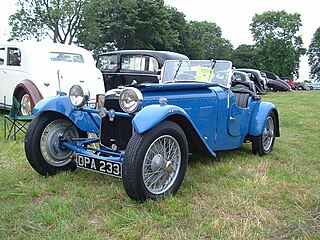Related Research Articles

Bristol Cars were manufacturers of hand-built luxury cars headquartered in Bristol, England. After being placed in receivership and being taken over in 2011, it entered liquidation in February 2020.

Nash Motors Company was an American automobile manufacturer based in Kenosha, Wisconsin from 1916 to 1937. From 1937 to 1954, Nash Motors was the automotive division of the Nash-Kelvinator Corporation. Nash production continued from 1954 to 1957 after the creation of American Motors Corporation.

Adams was an English automobile manufactured in Bedford, England, between 1905 and 1914.

A. J. Stevens & Co. Ltd was a British automobile and motorcycle manufacturer in operation from 1909 to 1931. The company was founded by Joe Stevens in Wolverhampton, England. After the firm was sold, the name continued to be used by Matchless, Associated Motorcycles and Norton-Villiers on four-stroke motorcycles till 1969, and since the name's resale in 1974, on lightweight, two-stroke scramblers and today on small-capacity roadsters and cruisers. The company held 117 motorcycle world records.

A cyclecar was a type of small, lightweight and inexpensive car manufactured in Europe and the United States between 1910 and the early 1920s. The purpose of cyclecars was to fill a gap in the market between the motorcycle and the car. A key characteristic was that it could only accommodate two passengers sitting tandem style or passenger behind the driver.

L'Aster, Aster, Ateliers de Construction Mecanique l'Aster, was a French manufacturer of automobiles and the leading supplier of engines to other manufacturers from the late 1890s until circa 1910/12. Although primarily known as an engine mass manufacturer the company also produced chassis for coach-works and a complete range of components.

An overhead camshaft (OHC) engine is a piston engine where the camshaft is located in the cylinder head above the combustion chamber. This contrasts with earlier overhead valve engines (OHV), where the camshaft is located below the combustion chamber in the engine block.

Trojan was a British automobile manufacturer producing light cars between 1914 and 1965, and light commercial vehicles for a short time.

Frazer Nash was a brand of British sports car manufactured from 1922 first by Frazer Nash Limited founded by engineer Archibald Frazer-Nash. On its financial collapse in 1927 a new company, AFN Limited, was incorporated. Control of AFN passed to Harold John Aldington in 1929.

Chain drive is a way of transmitting mechanical power from one place to another. It is often used to convey power to the wheels of a vehicle, particularly bicycles and motorcycles. It is also used in a wide variety of machines besides vehicles.

Peter Mitchell-Thomson, 2nd Baron Selsdon won the 1949 24 Hours of Le Mans together with Luigi Chinetti in a Ferrari 166 MM.

The 1949 24 Hours of Le Mans was the 17th Grand Prix of Endurance, and took place on 25 and 26 June 1949. Luigi Chinetti won the race for a third time in the first Ferrari barchetta by driving 22.5 hours. This race also saw the death of British driver Pierre Maréchal when his Aston Martin DB2 was involved in an accident between Arnage and Maison Blanche around 1:00 a.m. Marechal had attempted to pass another car there and he hit an embankment and the hapless Briton was crushed by the overturning car.

Chater-Lea was a British bicycle, car and motorcycle maker with a purpose-built five-storey factory in Banner Street, EC1, in the City of London and, from 1928, premises at Letchworth, Hertfordshire. It was founded by William Chater-Lea in 1890 to make bicycle frames and components. It made cars between 1907 and 1922 and motorcycles from 1903 to 1935. William died in 1927 and the business was taken over by his sons John and Bernard. After vehicle production finished, the company remained trading as a bicycle component maker and contract manufacturer until 1987. The company relaunched in 2017 as a maker of high-end British manufactured bicycle components and launched its first new products in the summer of 2019.

The GN was a British cyclecar made in London, between 1910 and 1925, The name derived from its founders, H.R. Godfrey and Archibald Frazer-Nash. Production ceased in 1923 but the company kept trading until 1925.
Grahame-White was an early British aircraft manufacturer, flying school and later manufacturer of cyclecars.

HRG Engineering Company also known as HRG, was a British car manufacturer based in Tolworth, Surrey. Founded in 1936 by Major Edward Halford, Guy Robins and Henry Ronald Godfrey, its name was created from the first letter of their surnames. Cars were produced under the HRG name from 1935 to 1956.
Archibald Goodman Frazer Nash, was an early English motor car designer, engineer, and inventor who specialised in manufacturer of light "cycle cars" and sports cars in England.
Ronald Godfrey (1887–1968), full name Henry Ronald Godfrey, was an English motor car design engineer of the first half of the 20th century possibly best known for his successful Singer-engined H R G thoroughbred sports cars built between 1935 and 1956.
The 1938 HRG Airline Coupe is a one-off British sports car powered by a 1500cc Triumph Gloria engine and gearbox. It was made by HRG Engineering Company with a body by Crofts Coachbuilding.
References
- The Chain-Drive Frazer Nash by David A. Thirlby, MacDonald & Co. Ltd, 1965
- Frazer Nash by David A. Thirlby, The Haynes Publishing Group, 1977 ISBN 0-85429-183-0
- From Chain-Drive to Turbocharger: The A.F.N. Story by Denis Jenkinson, Patrick Stephens Limited, 1984 ISBN 0-85059-631-9